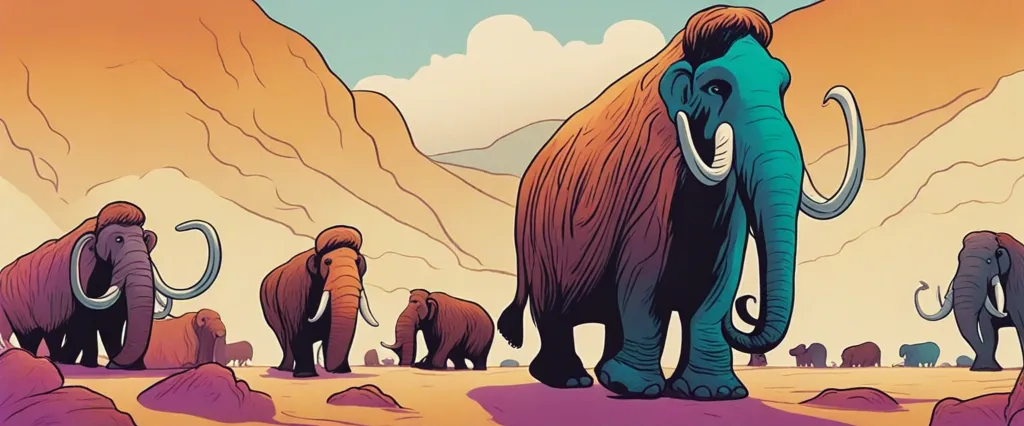In “Woolly” by Ben Mezrich, readers are taken on an exhilarating journey into the world of de-extinction, where scientists strive to bring long-extinct creatures back to life. Through the captivating story of Dr. George Church and his team, Mezrich sheds light on the awe-inspiring potential and ethical dilemmas of this groundbreaking scientific endeavor. With his signature flair for storytelling, Mezrich combines scientific discovery and thrilling narrative to explore the cutting-edge frontiers of genetic engineering. As an accomplished author, Mezrich has penned several New York Times bestselling books, including “The Accidental Billionaires,” which was adapted into the critically acclaimed film “The Social Network.” With “Woolly,” he once again demonstrates his ability to draw readers into the captivating realms of science and technology.
Chapter 1: The Resurrectionists
Chapter 1 of the book “Woolly” by Ben Mezrich introduces us to the concept of de-extinction and the ambitious project to bring the woolly mammoth back to life. The chapter focuses on the emergence of a secretive company called Colossal, led by tech billionaire and entrepreneur, Ben Latham, who envisions resurrecting this extinct species using advanced genetic engineering techniques.
Ben Latham, accompanied by his brilliant scientist-turned-business partner, George Church, presents his plan to a group of potential investors. Latham’s pitch revolves around the idea that the return of the woolly mammoth can help combat climate change. By reintroducing this prehistoric animal to the Arctic tundra, they hope to recreate a lost ecosystem and slow down the melting of polar ice.
However, many remain skeptical about the feasibility and ethics of de-extinction. Some critics argue that this endeavor might divert attention and resources from existing conservation efforts. Others express concerns about the potential unintended consequences or complications that could arise from bringing back an extinct species.
Nevertheless, Latham’s vision, backed by George Church’s scientific expertise, captivates some influential investors. As a demonstration of their progress, Colossal acquires a limited license to work on the mammoth project using already available DNA samples, promising a live woolly mammoth within five years.
The chapter concludes with Latham’s belief that by disrupting the norms and pushing boundaries, they can make a difference in the world. Thus, Chapter 1 sets the stage for the rest of the book, introducing us to the key players and their mission to bring the woolly mammoth back from the dead.
Chapter 2: The Mammoth Mystery
Chapter 2 of the book “Woolly” by Ben Mezrich, titled “The Mammoth Mystery,” delves deeper into the quest to bring the extinct woolly mammoth back to life through genetic engineering. The chapter begins with George Church, a renowned Harvard geneticist, making significant strides in this scientific endeavor.
Church’s primary objective is to utilize the recently developed gene-editing technology known as CRISPR to resurrect the woolly mammoth. By obtaining DNA remnants from mammoth fossils, Church and his team aim to splice the necessary genes into the genetic code of an Asian elephant, the closest living relative to the mammoth. This process requires complex knowledge of mammoth genomics and an understanding of how genes can be activated or deactivated to produce woolly mammoth traits such as thick hair and cold-resistance.
Mezrich explores the critical role of Viktor Zharov, a renowned Russian mammoth hunter and scientist, in this project. Zharov, with his extensive knowledge of mammoths and expertise in finding well-preserved remains in Siberia, becomes a key collaborator for Church’s team.
The chapter also highlights the ethical concerns surrounding de-extinction. Church and his team face criticism from conservation groups who argue that limited resources should be directed towards protecting existing endangered species rather than resurrecting extinct ones. Additionally, skeptics question the environmental impact of reintroducing the woolly mammoth and whether its recreation serves any significant purpose beyond scientific curiosity.
Overall, Chapter 2 of “Woolly” presents an intriguing exploration of the scientific advancements and ethical dilemmas involved in the ambitious pursuit to bring back the woolly mammoth.
Chapter 3: The Frozen Giants
Chapter 3 of “Woolly” by Ben Mezrich, titled “The Frozen Giants,” introduces the scientific expedition to Siberia led by renowned geneticist Dr. George Church. The chapter divulges into the purpose and significance of their journey, as well as the challenges they face.
Dr. Church’s team intends to retrieve ancient DNA from frozen mammoths in order to potentially bring the extinct species back to life through genetic engineering. The chapter elucidates the allure of this ambitious project—recreating a lost species offers opportunities for scientific breakthroughs and could contribute to preserving biodiversity in the face of climate change.
The expedition faces multiple obstacles right from the start. Transporting cutting-edge equipment to the remote Siberian tundra proves to be a logistical nightmare, but they manage to secure the necessary resources and set up a lab near the Kolyma River. The Kolyma region is known for its pristine permafrost, which has preserved countless mammoth remains for thousands of years.
As the team begins the painstaking process of extracting DNA from the frozen carcasses, they face another challenge—an alarming rate of decay due to global warming. Rising temperatures are causing the permafrost to melt rapidly, jeopardizing the genetic material critical for their research.
The chapter highlights the race against time as the scientists work diligently to extract and sequence as much genetic material as possible. Dr. Church’s team faces the continuous threat of losing this precious resource due to climate change.
In conclusion, “The Frozen Giants” chapter in “Woolly” introduces the scientific expedition led by Dr. George Church to Siberia, with the objective of extracting ancient DNA from frozen mammoths. The chapter emphasizes the challenges they encounter, including logistical barriers and the accelerated decay of the remains due to global warming. This sets the stage for the high-stakes and time-sensitive nature of their groundbreaking endeavor.
Chapter 4: The Genetic Puzzle

Chapter 4 of the book “Woolly” by Ben Mezrich delves into the complex genetic puzzle surrounding the resurrection of the Woolly Mammoth. The chapter begins with the author’s visit to the Ice Age Lab in South Korea, where Professor Hwang Woo Suk and his team are attempting to clone the extinct creature. Mezrich describes the lab’s efforts to extract DNA from well-preserved mammoth samples in Siberia, meticulously analyzing the genetic material to fill in the gaps.
The chapter highlights the challenges faced by the scientists due to the degraded nature of the mammoth DNA. The team devises a strategy called “shotgun sequencing” to assemble the gene fragments, piecing together small parts of the mammoth genome into a more complete sequence. However, the complexity of the mammoth’s genome makes this process incredibly difficult, requiring advanced computational techniques and intensive data analysis.
Mezrich also focuses on the collaboration between Professor Hwang and Dr. George Church, a prominent geneticist at Harvard University. They combine their expertise to solve the genetic puzzle, working on finding the appropriate “gene editor” tool to modify the Asian elephant’s genome to match that of the mammoth. The chapter provides insight into the cutting-edge genetic technologies involved in reassembling the mammoth’s genome and editing elephant DNA.
Overall, Chapter 4 explores the intricate scientific challenges associated with recreating the Woolly Mammoth. The chapter highlights the meticulous processes involved, ranging from DNA extraction to genome assembly and gene editing, while emphasizing the collaboration between scientists from different fields. It leaves readers eager to discover if these efforts will eventually culminate in the successful resurrection of the long-extinct species.
Chapter 5: The Cloning Controversy
Chapter 5 of the book Woolly by Ben Mezrich, titled “The Cloning Controversy,” delves into the heated debate surrounding the potential resurrection of extinct species through advanced cloning technology. The chapter primarily focuses on the work of Dr. George Church, a prominent geneticist leading the effort to bring the woolly mammoth back to life.
The chapter begins by exploring the clash between preservationists, who argue that cloning extinct species is an opportunity to rectify the ecological damage humans have caused, and conservationists, who believe the focus should be on protecting currently endangered animals. The moral and ethical implications of “de-extinction” lead to passionate discussions around the world.
Dr. Church, along with his team at Harvard University, explores the possibility of recreating the woolly mammoth using genetic samples preserved in permafrost. By inserting mammoth DNA into the genome of a closely related Asian elephant, they hope to create a hybrid species capable of withstanding cold temperatures. The potential resurrection of these ancient creatures sparks both excitement and concern among scientists and the public.
The chapter further examines various perspectives on the cloning controversy. Some argue that de-extinction is a waste of resources that could be better used to address present-day conservation challenges. Others believe that it is a chance to learn more about extinct species and to potentially restore lost biodiversity.
Despite the uproar, Dr. Church and his team remain dedicated to their ambitious mission. They aim to ultimately release a small herd of woolly mammoths into the Arctic wilderness, not only fulfilling the dream of bringing a species back from the dead but also potentially helping to combat global warming by restoring the grasslands that the animals once grazed.
In the midst of the ongoing cloning controversy, the chapter leaves readers with the lingering question of whether humans should play God and meddle with the natural order of the world in an attempt to rectify the past.
Chapter 6: The Revivalists
Chapter 6 of “Woolly” by Ben Mezrich, titled “The Revivalists,” delves into the controversial field of de-extinction and the efforts of a group of scientists to bring the woolly mammoth back to life.
The chapter begins with the introduction of three prominent figures in the field: George Church, a renowned geneticist at Harvard University; Stewart Brand, an influential environmentalist and founder of The Long Now Foundation; and Sergey Zimov, a Siberian ecologist. These three enterprising individuals form the core of a bold plan to resurrect the woolly mammoth and potentially reverse the effects of climate change.
Mezrich explains that this group faces significant scientific and ethical hurdles. The geneticists, led by Church, aim to reassemble the extinct mammoth DNA puzzle by gathering small fragments of ancient DNA and using modern elephant DNA as a template for recreating the missing genes. However, these efforts are still in the early stages, and they encounter a number of challenges in obtaining viable samples and cloning technology.
Meanwhile, Sergey Zimov operates Pleistocene Park, an experiment in Siberia aimed at recreating the grassy steppe environment that woolly mammoths once thrived in. Zimov believes that the reintroduction of mammoths could help restore the landscape and mitigate the effects of global warming by treading down the layers of insulating snow and promoting the growth of grass.
Throughout the chapter, the author highlights the controversies surrounding de-extinction, such as concerns over the ethical implications, conservation priorities, and the potential unintended consequences of introducing a genetically modified species to the ecosystem.
In summary, Chapter 6 explores the endeavors of a group of scientists dedicated to resurrecting the woolly mammoth and the intricate challenges they face in their quest for de-extinction.
Chapter 7: The Mammoth Park
Chapter 7 of the book “Woolly” by Ben Mezrich, titled “The Mammoth Park,” explores the fascinating world of genetic engineering and the ambitious project to resurrect the extinct woolly mammoth. The chapter starts with a vivid description of a meeting taking place at Harvard University’s Northwest Building in Cambridge, Massachusetts.
In this meeting, renowned geneticist George Church and his team, including postdoctoral student Eriona Hysolli, propose an audacious plan to bring back the woolly mammoth through a process called de-extinction. In order to achieve this, they aim to create a hybrid animal using Asian elephants and genes from the ancient mammoth using CRISPR gene-editing technology.
Church believes that reviving the woolly mammoth is not only beneficial for ecological restoration but also has the potential to mitigate the effects of climate change. Mammoths were adept at influencing their environment, and reintroducing them could help slow down the degradation of the Arctic permafrost.
The chapter then shifts to South Korea, where Jurassic Park-style labs are being built underground to house the genetically engineered creatures. It introduces Hwang Woo-suk, a controversial scientist who gained international attention for his team’s alleged cloning of human embryos but was later discredited. Hwang’s involvement in the mammoth project raises concerns among the team members, but Church believes the positive aspects outweigh the potential risks.
The chapter concludes with Hysolli and her team working diligently on their experiments and Church remaining confident about the future of the woolly mammoth resurrection project. Despite the hurdles they face, their dedication to pushing the boundaries of science and unraveling the mysteries of genetics remains unwavering.
In summary, Chapter 7 of “Woolly” delves into the ambitious plan to resurrect the woolly mammoth through genetic engineering, exploring the motivations, potential benefits, and the challenges faced by the scientists involved.

Chapter 8: The Legacy of Woolly
Chapter 8 of the book “Woolly” by Ben Mezrich, titled “The Legacy of Woolly,” addresses the aftermath and implications of the creation of a synthetic woolly mammoth. It begins with a meeting between George Church and returning customer Ryan Phelan in a restaurant, where Church reveals that his team has successfully modified a mammoth cell and is now ready to proceed with the next steps.
Phelan is thrilled by the breakthrough and offers more funding, expressing his strong belief in the potential of de-extinction. Following this development, Beth, a member of Church’s team, contacts Church and requests to become involved in the next phase of the project. Although he initially hesitates, Church ultimately agrees to include her.
Meanwhile, Church visits Sergey Zimov and his Pleistocene Park in Siberia, where they discuss the potential reintroduction of woolly mammoths to aid in combating climate change. They agree that in order for this vision to become a reality, Church’s synthetic mammoth project must succeed.
Later in the chapter, the focus shifts to a hearing in Washington, D.C. where Church is among the panelists invited to discuss the future of de-extinction. The debate is lively, with proponents arguing that bringing back extinct species could help preserve biodiversity, while opponents caution against playing god and the potential consequences of resurrecting long-gone creatures.
Ultimately, the chapter leaves readers on a hopeful note, with Church’s synthetic mammoth project gaining momentum and strong support. The legacy of “Woolly” lies in the possibilities it presents, not only for the resurrection of long-extinct species but also for the potential benefits they could bring to our environment and understanding of evolution.
After Reading
In conclusion, Woolly by Ben Mezrich delves into the fascinating world of de-extinction and the controversial pursuit of resurrecting the extinct woolly mammoth. Mezrich takes readers on a thrilling and thought-provoking journey, exploring the scientific advancements, ethical dilemmas, and larger implications of this groundbreaking endeavor. Through vivid storytelling and meticulous research, the author offers a balanced exploration of the potential benefits and risks associated with bringing back such ancient creatures. Engaging and thought-provoking, Woolly challenges readers to consider the complex intersections between science, ethics, and the preservation of Earth’s delicate ecosystems.
1. The Gene: An Intimate History” by Siddhartha Mukherjee – This book explores the history and science behind genetics, including the controversial topic of genetic engineering. Like “Woolly,” it provides fascinating insights into the ethical implications and potential consequences of manipulating our genetic makeup.
2. “Evolving Ourselves: How Unnatural Selection and Nonrandom Mutation are Changing Life on Earth” by Juan Enriquez and Steve Gullans – This thought-provoking book delves into the future of human evolution, discussing how technological advancements could shape our species and the moral dilemmas associated with altering our genetic code.
3. “Regenesis: How Synthetic Biology Will Reinvent Nature and Ourselves” by George Church and Ed Regis – Exploring the emerging field of synthetic biology, this book investigates the possibilities of genetic engineering and its impact on humanity and the environment. It shares similarities with “Woolly” by providing insights into the ethics surrounding groundbreaking scientific developments.
4. The Immortal Life of Henrietta Lacks” by Rebecca Skloot – This gripping narrative nonfiction book tells the story of Henrietta Lacks, whose cells were unknowingly taken for medical research and have been used extensively in scientific advancements. It raises important questions about bioethics, the ownership of genetic material, and the implications of medical research on individuals and society.
5. Sapiens: A Brief History of Humankind” by Yuval Noah Harari – Although not directly focused on genetic engineering, this book offers a captivating exploration of human history and the development of our species. It delves into the cognitive and cultural revolutions that have shaped Homo sapiens, touching on topics that intersect with the ethical considerations explored in “Woolly.”



